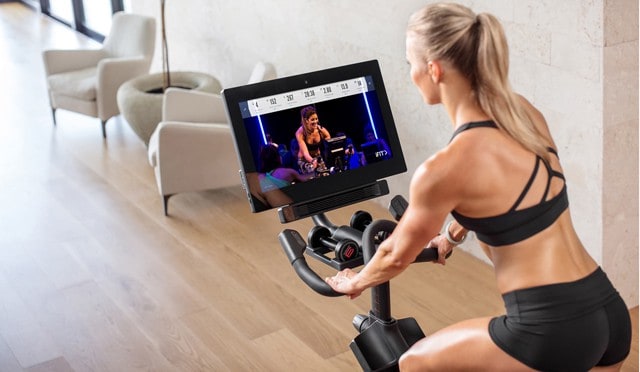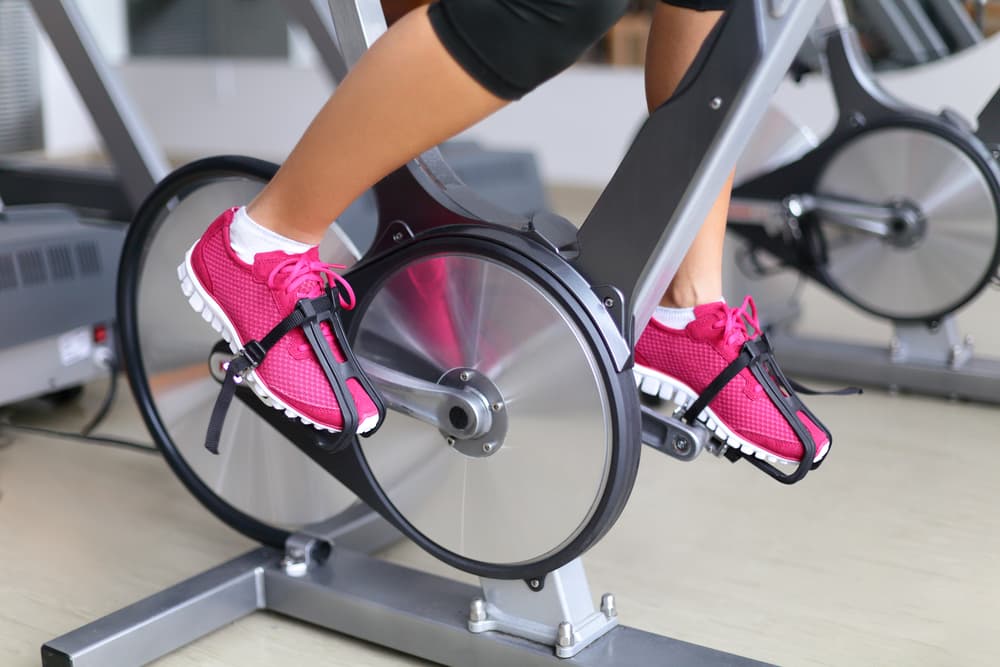Returning to the best version of our former selves after injury or surgery is a difficult and sometimes laborious process. It is however crucial to begin the rehabilitation process and maintain a consistent level of input if we want to give the body the appropriate stimulus to heal as best as possible. Using an indoor bike is often one of my favourite ways of doing this.
Regardless of the type of bike you choose to use, indoor cycling allows us to create a low impact, safe environment for kickstarting the journey back to full fitness.
That said, there is now an overwhelming choice of bike types and brands – all self-proclaiming to be unique and superior to the competition in one way or another.
In this article, I give my opinion from a physiotherapy perspective on the benefits and disadvantages of smart bikes versus regular exercise bikes when returning from injury or surgery.
So, What’s The Difference?

Smart Bikes
Smart bikes, such as the Peloton indoor bike, are really the cream of the crop when it comes to indoor bikes. I find them to be highly entertaining thanks to their ability to connect to global communities which allows the user to take part in live cycling and exercise classes.
- Built-in Technology
Smart bikes are highly connective and provide streams of invaluable data feedback usually via a mobile app. This is great for a user looking to push their training on to the next level. As a highly automated piece of kit, they can control a lot of variables, such as resistance and power output.
- Larger Dimensions
Due to the addition of all this tech, a smart bike tends to be slightly larger and heavier than other types of stationary bikes. The Peloton for example weighs in at 135kg/ 297lbs with dimensions of 24”x48” at the base. In other words, once you’ve got it there, it’s staying there!
- Sportier Saddle
In terms of fit, they are very similar to any other stationary bike. The saddle on a smart bike is often sportier and more akin to that of a road bike, which may not suit those unfamiliar with cycling.
If I do go for a bike with this kind of saddle then I like to make sure it has a central cut-out. This provides more ventilation for long periods of use, and crucially reduces pressure around the pudendal nerve. As a male cyclist myself this is highly appreciated!
- Set-Up
Knee and hip angles can be set up much the same as a regular exercise bike, providing the bike allow you to change the height and reach of the saddle. This is very important for those with painful knees or restricted range of motion, either post-surgery or due to osteoarthritis.

Regular Exercise Bikes
A regular exercise bike could be one of three things: an upright stationary bike, a spin bike, or a recumbent bike. Each of these variations come with their own unique features and subsequent advantages and disadvantages versus one another.
- Upright Stationary Bike
An upright stationary bike is the most common one that you will often see in gyms and rehab clinics. They often use an internal flywheel with magnetic resistance to give the user a wider range of pedal resistance.
Most stationary bikes come with a multi-functional LCD display which helps to keep track of progress by tracking speed, distance, time, calories burnt, pulse rate and power output.
The seat is usually much more padded and wider than that of a smart bike or spin bike, this is preferred for those who are newer to cycling and want extra comfort.
- Spin Bike
Spin Bikes are explicitly different to an upright stationary bike in two crucial ways. This comes down to positioning and flywheel setup.
A spin bike is set up to position the user as if they were cycling an outdoor road bike. The handlebars usually have a greater incline, encouraging you to lean forward and put more weight through the forearms. The resultant effect is twofold; increased power output on the pedals, and a forward-tilted pelvic posture.
The flywheel on a spin bike is usually exposed and heavier than that of a stationary bike. Some use a belt-drive transmission and others stick with the magnetic resistance.
Due to the heavy flywheel, the pedals do not immediately come to a stop when you do. This means that the pedals will continue to turn, slowly coming to a stop once the momentum has dissipated. You should never try to come to a dead stop on a spin bike as this is likely to cause an injury. Almost all spin bikes come with an emergency brake attached for this reason.
- Recumbent Bike
Finally, a recumbent bike has a backrest that leans backwards slightly allowing the user a more comfortable reclined seating position. They usually also have handlebars next to the seat which give more stability to those who may struggle to maintain the upright sitting position.
A seat on a recumbent bike is usually wider and more padded which again increase comfort versus other stationary upright bikes and smart bikes.
Recumbent bikes are usually a less intense workout, making them more suitable for beginners or those with health/ joint conditions.

My Recommendations
- After Injury or Surgery
From a rehabilitation perspective, I would almost always start my patients off on a stationary upright or recumbent bike. In the early stages after an injury or surgery, it is important to have as much control over the environment as possible to avoid placing too much strain on the healing structures.
- Older Adults or Those with Arthritic Joints
For my patients who come to me with arthritic joints, I often find that they prefer the comfort of the reclined seating position and shallower degree of peak knee flexion when using a recumbent bike. Additionally, due to the typical demographic of this patient being the older adult at risk of falls, they also benefit from the increased stability of the larger padded seat and handles.
- Fit & Young
When working in sports and with younger patients, I tend to favour the upright stationary bike. This is a great tool for keeping aerobic fitness ticking over and maintaining or improving general conditioning during a lengthy rehab process.
- No Lower Limb Injury Concerns
If there are no lower limb injury concerns then I would also be happy to utilise a smart bike, because as we know these are far more entertaining and motivation is a key ingredient in the return to full fitness!
The main downside to smart bikes in my mind is the cost and size. This is of no concern in a gym or clinic setting where space and resources are of no consequence. However, for the average person looking to exercise at home, I would say a normal stationary upright bike is much more budget and space-friendly.
Alternatives to Smart Bikes
If you are considering an alternative to smart bikes then I would recommend checking out our recent article here.
If however, you have decided that a smart bike is the bike for you then we’ve got you covered. See our comparison of the best peloton bike alternatives for all the information you require.
In Summary
In summary, I would say that each bike has its place. You need to consider all your individual factors including age, fitness, injuries and other health conditions.
If you are still unsure after reading this article then as always, reach out to appropriately qualified health and fitness professionals or physiotherapists for more advice.
- Isometric vs Isotonic vs Isokinetic Exercises: Explained - 12 August 2022
- Is Pilates Better Than Weight Training? - 29 March 2022
- Can You Use A Massage Gun For Carpal Tunnel Syndrome? - 16 March 2022
